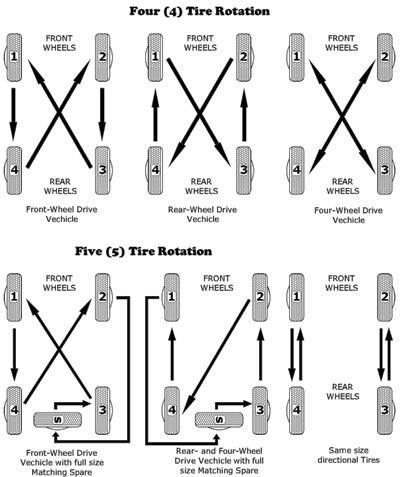Knowing how to change a tire is a necessary skill for all drivers. If you rely on a cell phone to save you in a roadside emergency, there’s always that chance you will forget to charge it, be out of range, or leave it at home. Flat tires can happen anywhere, and a cell phone is no substitute for knowing how to change a flat tire.
Thankfully, changing a tire isn’t all that hard! Just adhere to the following guidelines to be prepared in case you have a flat.
These items should have come with your vehicle:
Jack
Lug wrench
Fully inflated spare tire
Vehicle owner’s manual
If you have misplaced any of these items, or if your car did not come with these items, you should purchase new ones right away. And be sure you’re regularly inflating the spare tire to your vehicle manufacturer’s recommended PSI. You should check the spare’s air pressure every time you check your other tires.
Remember to check pressure every month and before long trips or carrying extra load.
Here are some items that don’t come with your vehicle but that you should stow in your trunk or glove box in case you have to change a flat tire:
Flashlight with working batteries
Rain poncho
Small cut of 2"x6” wood to secure the jack
Gloves
Wheel wedges
As soon as you realize you have a flat tire, do not abruptly brake or turn. Slowly reduce speed and scan your surroundings for a level, straight stretch of road with a wide shoulder. An empty parking lot would be an ideal place. Level ground is good because it will prevent your vehicle from rolling. Also, straight stretches of road are better than curves because oncoming traffic is more likely to see you.
Never attempt to change your tire on a narrow shoulder near oncoming traffic. Keep moving (slowly) until you find a safer spot. While driving on a flat risks ruining your rim, replacing a rim is better than being hit by an inattentive driver.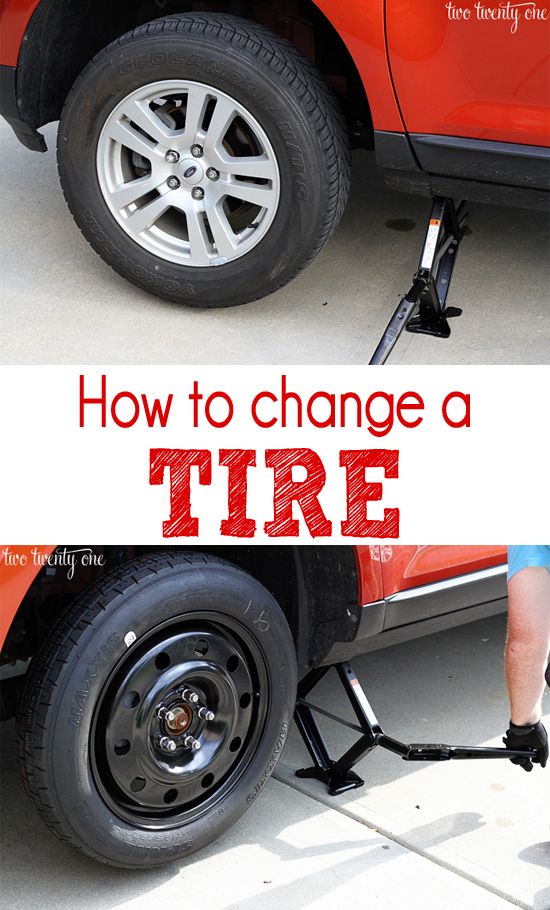
Make sure to consult your owner’s manual and review their specific steps on how to change a flat tire for your vehicle
Your hazard lights or “flashers” will help other drivers see you on the side of the road. To avoid an accident, turn them on as soon as you realize you need to pull over.
Once stopped, always use the parking brake when preparing to replace a flat tire. This will minimize the possibility of your vehicle rolling.
Wheel wedges go in front of or behind the tires to further ensure the vehicle doesn’t roll while you fix the flat tire. If you’re changing a rear tire, place these in front of the front tires. If your flat tire is at the front, put the wheel wedges behind the rear tires.
Bricks or large stones will work just as well as “real” wheel wedges. Just be sure they’re large enough to stop the car from rolling.
If your vehicle has a hubcap covering the lug nuts, it’s easier to remove the hubcap before lifting the vehicle with the jack. If your lug nuts are exposed, you can skip ahead to Step 6.
If your lug nuts are exposed, you can skip ahead to Step 6.
Use the flat end of your lug wrench to remove the hubcap. This will work for most vehicles, but some hubcaps need a different tool to come off. Consult your owner’s manual for proper hubcap or wheel cover removal procedures.
Using the lug wrench, turn the lug nuts counterclockwise until you break their resistance. You may have to use force, and that’s ok. Use your foot or all of your body weight if necessary.
Loosen the lug nuts about ¼ to ½ of a turn, but don’t remove them completely yet. Save that for when it’s time to remove your tire/wheel from the vehicle.
The right place for the jack is usually beneath the vehicle frame alongside the tire that’s flat. Many vehicle frames have molded plastic on the bottom with a cleared area of exposed metal specifically for the jack. To safely lift and avoid damage to the vehicle, follow the instructions for jack placement in your vehicle owner’s manual.
To prevent the jack from settling under the weight of your vehicle and coming off balance, place a small cut of 2x6” wood beneath it before attempting to raise your vehicle. This tactic is especially helpful on asphalt.
With the jack properly positioned, raise the vehicle until the flat tire is about six inches above the ground.
Never put any part of your body under the vehicle during or after raising the vehicle with the jack.
Now it’s time to remove the lug nuts all the way. Since you've already loosened them, you should be able to unscrew them mostly by hand.
Gripping the tire by the treads, pull it gently toward you until it’s completely free from the hub behind it. Set it on its side so that it doesn’t roll away.
Now place the spare on the hub by lining up the rim with the lug bolts. Push gently until the lug bolts show through the rim.
Put the lug nuts back on the lug bolts and tighten them all the way by hand. Once they are all on, check each one again, tightening as much as possible. You will tighten them with the wrench after lowering the vehicle to the ground.
Use the jack to lower the vehicle so that the spare tire is resting on the ground but the full weight of the vehicle isn’t fully on the tire. At this point, you should tighten the lug nuts with the wrench, turning clockwise, as much as you can. Push down on the lug wrench with the full weight of your body.
Bring the vehicle all the way to the ground and remove the jack. Give the lug nuts another pull with the wrench to ensure they’re as tight as possible.
If the hubcap you took from the flat tire will fit your spare, put it in place the same way you removed it initially.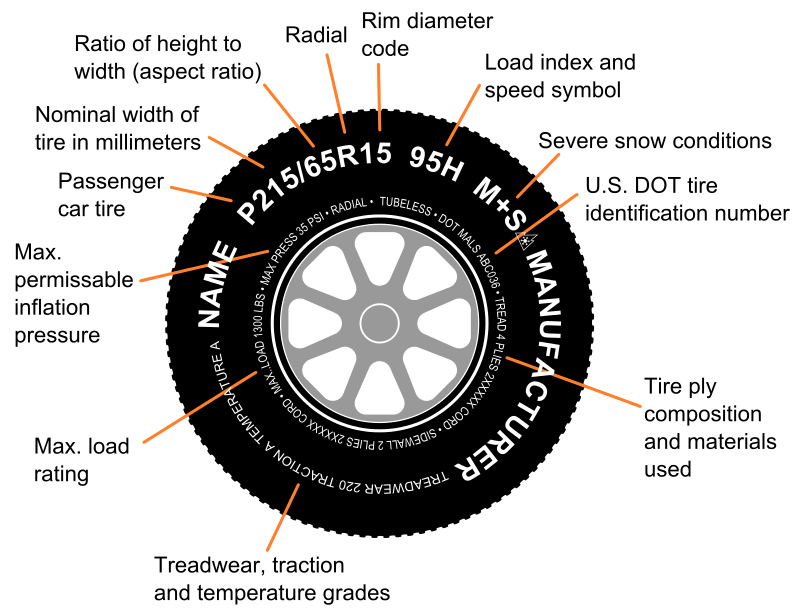 If it doesn’t fit, stow it away with the tire when you stow your equipment.
If it doesn’t fit, stow it away with the tire when you stow your equipment.
You have before you a jack, a lug wrench, wheel wedges, your flat tire, and possibly a hubcap. Don’t forget to put all of them in your vehicle before driving away.
You should check the tire pressure of the spare tire to make sure that it is safe to drive on. “T-Type” temporary spares, also called “mini-spares,” require 60 psi (420 kPa). If the tire needs pressure, drive (slowly) to a service station immediately.
Temporary spare tires aren’t made to drive long distances or at high speeds, so drive cautiously until you’re able to visit a tire technician. A professional should be able to determine whether your tire needs a repair or if it’s time to replace it.
Aside from taking your tire to a professional, the above procedure shouldn’t take more than 15 to 30 minutes to change a tire. Just be sure you don’t leave out any steps.
Just be sure you don’t leave out any steps.
It’s beneficial practice changing a tire in your garage or driveway to ensure you’re ready to handle this situation if it ever happens to you.
Knowing how to fix a flat tire is great, but regular tire maintenance is even more important. In addition to reviewing this guide regularly, remember to do the following:
Keep your tires properly inflated
Rotate your tires according to the manufacturer’s guidelines
Monitor for tread wear
All of these precautions will extend the life of your tires and reduce the likelihood of a flat. While there’s no way to prevent flat tires completely, proper care can improve performance and ensure your tires last as long as possible.
There’s never a good time for a flat. That’s why Bridgestone DriveGuard tires are masterfully engineered to keep you moving for up to 50 miles at speeds up to 50 MPH without disruption.
There’s never a good time for a flat. That’s why Bridgestone DriveGuard tires are masterfully engineered to keep you moving for up to 50 miles at speeds up to 50 MPH without disruption.
See Details Find Your Fit
Almost every car on the road has a spare tire, but do you know how to use it? Better yet, do you even know where it is? It seems that many people don’t even realize they have one, and we’ve seen spare tires in 15-year-old vehicles that have never seen the light of day. Chances are you, too, may never need to use one, but it’s a good thing to know. After all, you never know if you might wake up to a flat tire in your driveway or have the TPMS (tire pressure monitoring system) give you a warning out on the highway.
If you think about it, a tire is basically a balloon, albeit a very serious balloon. Made of steel and fabric bands encased in rubber, your tires give you traction, control, and a measure of shock absorption. Still, as a balloon, it can be deflated. Road debris, such as stray car parts or sharp rocks, can puncture the tire. The tire may leak from the valve stem or between the tire and the wheel. In some cases, wheel damage, such as a bent or cracked rim, can allow air to leak from the tire.
Made of steel and fabric bands encased in rubber, your tires give you traction, control, and a measure of shock absorption. Still, as a balloon, it can be deflated. Road debris, such as stray car parts or sharp rocks, can puncture the tire. The tire may leak from the valve stem or between the tire and the wheel. In some cases, wheel damage, such as a bent or cracked rim, can allow air to leak from the tire.
The result is a flat tire, and they can happen to everyone. It doesn’t matter who you are, what vehicle you drive, or even how you drive it. Still, everything you need to know is right there in your owner’s manual, which you should get to know intimately. If you don’t have your owner’s manual, you can buy one from your dealer or Amazon or eBay. You might be able to download it for free at JustGiveMeTheDamnManual.com. In case you get a flat tire, here’s what you need to know.
There are three kinds of spare tire, depending on the vehicle. If your vehicle is equipped with a full-size spare, then it works the same as the tires already mounted on your vehicle. If your vehicle has alloy wheels, the spare may be mounted on an alloy wheel or a steel wheel, and different lug nuts may be required.
If your vehicle is equipped with a full-size spare, then it works the same as the tires already mounted on your vehicle. If your vehicle has alloy wheels, the spare may be mounted on an alloy wheel or a steel wheel, and different lug nuts may be required.
The temporary spare or compact spare, sometimes referred to as a “donut,” is narrower than the tires mounted on your vehicle and may be of a smaller diameter. As its designation suggests, it is for temporary use only, for a limited distance and maximum speed.
Vehicles equipped with run-flat tires are usually not shipped with a spare tire, and may not even include a space for one. Instead, run-flat tires are built with extra-strong sidewall materials. If a run-flat tire goes flat, you can still drive it but, like temporary spare tires, for a limited distance and speed.
While you can use a full-size spare under all the same conditions, speeds, and distances of the regular tires, use caution when driving with a temporary spare or run-flat tire. The temporary spare and run-flat tire are only meant to be used for a limited distance and speed. Exceed that distance or speed and you could ruin the tire, your car, or lose traction and get into an accident. Replace a temporary spare or run-flat tire as soon as possible.
The temporary spare and run-flat tire are only meant to be used for a limited distance and speed. Exceed that distance or speed and you could ruin the tire, your car, or lose traction and get into an accident. Replace a temporary spare or run-flat tire as soon as possible.
Once you discover you have a flat tire, you’ll have to replace it with the spare tire. It’s a good idea to practice this on a nice day if you can. Full instructions for your specific vehicle can be found in your owner’s manual, but here are the basic steps you need to follow.


Tires don’t last forever, but we can help you make them last. At Dobbs Tire & Auto Centers, our ASE Certified technicians keep up-to-date on the latest tire maintenance and repair techniques. If you have a tire problem or you’re running on your spare tire right now, come in and talk to one of our experienced technicians about your repair options. With 42 locations, there’s bound to be one convenient to your home, job, or school.
Getting a flat tire is one of the many automotive problems that can strike without warning at any time of the day or night. Even if you are sure that you have nothing to fear in the event of a puncture, since you have a spare tire, damage to the wheel will interrupt your movement on the road anyway and cause a lot of trouble. The worst thing is that if you have a spare wheel, you will not be able to change it for a damaged wheel if you don't know how to do it. In this case, you will have to call a help desk or a tow truck, which will cost a considerable amount. Maybe it's better to learn how to change wheels on a car?
The worst thing is that if you have a spare wheel, you will not be able to change it for a damaged wheel if you don't know how to do it. In this case, you will have to call a help desk or a tow truck, which will cost a considerable amount. Maybe it's better to learn how to change wheels on a car?
Learning how to change tires will not only save you time, but also greatly reduce your assistance costs. Our online publication offers you a guide with which you will learn that changing a self-damaged tire to a spare one is really not difficult.
But before we tell you how, here are some precautions you should take when changing wheels.
- Keep the spare tire in good condition . If you puncture a tire and your spare tire is not fit for installation, then this will bring unnecessary problems. Therefore, remember the spare wheel must be in good condition. When checking tire pressures, be sure to check the spare tire pressure as well.
- Remember that you must do this at least once a month. In addition, when checking the condition of the wheels on the car, do not deprive your attention of the spare wheel, which also should not have cracks and other damage that may occur due to temperature changes or tire age.
- Never change a tire on the freeway. Remember that changing a wheel on the highway, you risk being in a serious accident. After all, it is not uncommon when many inexperienced and aggressive drivers overtake cars on the right, which often leads to accidents as a result. Believe me, you will not have time to escape. Therefore, we advise you to call for emergency assistance in case of damage to the wheel.
- Also, if you have a punctured tire and you have the opportunity to remove the car from the freeway, then drive the car to a safe distance from the road and only in this case change the wheel . If this is not possible, then, having called for help, do not stay in the car, but move away from it at a safe distance from it.
- Use Tire Puncture Repair Kit. Many auto shops and tire shops sell special kits for the quick repair of tire punctures.
- Be sure to get them even if you have spare wheel . Remember that there are times when, having punctured a wheel, you are not able to jack up the car in order to install a spare tire.
- Please note that many modern cars in recent years are no longer equipped with spare wheels. As a rule, instead of them, the manufacturer completes the car with special repair kits that can repair wheel damage.
- These repair kits will not repair many types of damage to tires. So don't count on them too much. Still, the "spare wheel" is a more reliable way to avoid problems on the road. Therefore, even if the manufacturer has not equipped the car with a spare wheel, we recommend that you purchase the wheel yourself. And of course, remember that a pump or an electric compressor must be in the trunk of a car.
- Be careful when jacking up the machine . Replacing a wheel is associated with raising the car with a jack, which is inserted into a special groove or "platform". If you are not careful or attentive, you risk that the car will either fall off the jack or move to the side.
Have you given up on the idea of learning how to change a wheel yourself? No. Then let's get to the most important part.
Before changing a wheel, make sure your car will not fall off the jack. To do this, make sure that the car is on a flat piece of land or asphalt. Also note that under the wheels of the car there should not be uneven surfaces, bumps or stones that can interfere with the process of jacking up the vehicle.
Including you have to make sure that the surface under the machine is hard enough.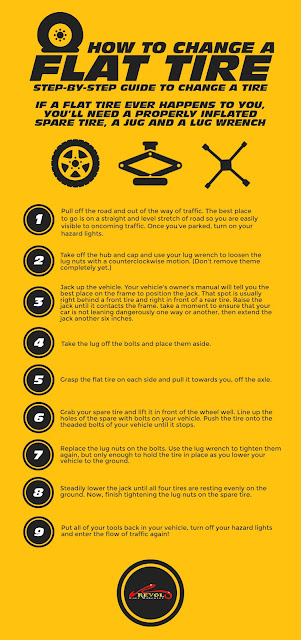 After all, by lifting one side of the car, its weight is redistributed to other wheels and in the case of a soft surface, the car can shift and fall off the jack. For example, be vigilant when changing a wheel on sand or when there is mud under the car. In order to understand whether the car can move on the jack, you need to slightly raise the car and shake it, watching the car and other wheels.
After all, by lifting one side of the car, its weight is redistributed to other wheels and in the case of a soft surface, the car can shift and fall off the jack. For example, be vigilant when changing a wheel on sand or when there is mud under the car. In order to understand whether the car can move on the jack, you need to slightly raise the car and shake it, watching the car and other wheels.
Along with the spare wheel, you must also carry a wheel wrench with which you can remove the wheel bolts . If you use secret bolts to protect the wheels from theft, then also do not forget to put a special key (secret) in the car so that you do not end up on the road in a hopeless situation when no one will help you except the tow truck.
If for some reason you do not know if you have a wheelbrace for changing wheels (for example, you just bought a car), then it is probably located next to the spare wheel in the trunk, or in the glove compartment or in the side pockets of the doors .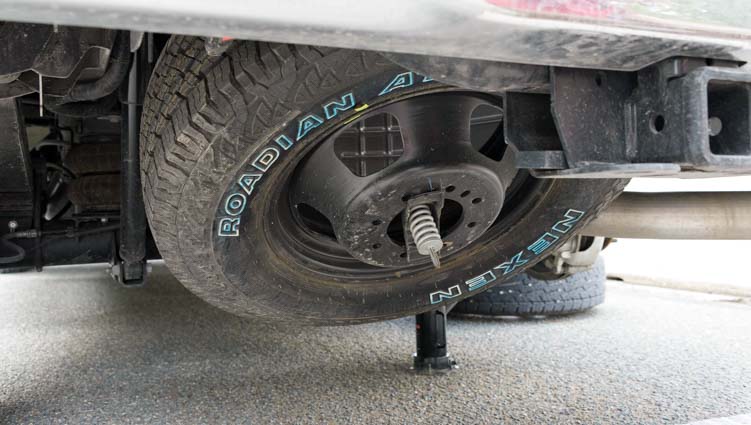
wheel change . Including the manual on the car will tell you exactly where the special socket for the jack is located and how you can get the spare tire out of the car.
The most dangerous thing that can happen when changing a wheel is if the vehicle moves or starts to roll . To make sure this doesn't happen, you first need to apply the car's handbrake, locking the rear wheels.
Next, if your car is equipped with a manual transmission, you need to turn off the engine, put the gearbox in first or reverse gear. If your vehicle is equipped with an automatic transmission, then set the box to "P" - parking.
Many people think that putting the car on the "handbrake" is enough to start jacking up the car to change the wheel. But it's not. The fact is that the handbrake blocks only the rear wheels, while setting the gearbox to speed will also block the front drive wheels (if your car is front-wheel drive).
Having done all of the above, you must manually block the other wheels by placing something heavy under them to prevent the wheel from moving. Of course, you can put something heavy not under each wheel. It will be enough to put under the tire, which is diametrically opposed to the wheel being replaced.
That is, if you change the left front wheel, you must definitely place something heavy under the right rear wheel to prevent the wheel from moving. It is advisable that you find bricks or stones and put them in front of the wheel and behind it, thereby blocking it from both sides.
Attention! This is a very important point . Be sure to loosen the wheel bolts before jacking up the vehicle. That is, by raising the car with a jack, you should effortlessly complete the process of unscrewing the bolts. In order to unscrew the nut or wheel bolt, remove the wheel wrench, install it on the wheel fastener.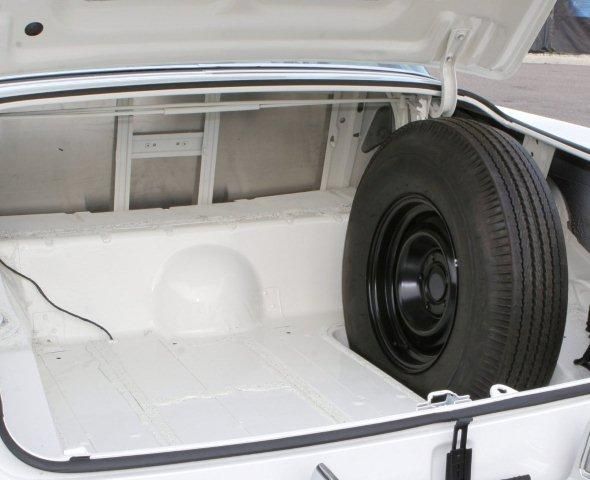
It is likely that you will need to position the key so that you can place a foot or two on it to turn the key under the weight of your body. Once the nut or bolt has begun to move, you can manually loosen it further.
The most important thing is not to over-tighten the wheel bolts, as your task is only to loosen them first. The main thing is that the wheels are still attached to the car and cannot fly off when the car is raised.
The jack is usually located in the trunk, either next to or under the spare tire, or in the special box . Also, in some cases, the jack may be located inside the cabin. Including there are also car models where the jack is under the hood.
In addition to loosening the wheel bolts, you must remove the spare wheel before jacking up the vehicle. The fact is that when the car is on the jack you should not rock the car in order to prevent it from falling.
Most modern cars have the spare wheel in the boot. As a rule, the trunk floor rises and a fixed spare wheel is located under it. In many cars, the spare wheel is fixed. How to remove the spare wheel from the car should be detailed in the manual for the car.
Find the correct place to mount the jack . Remember that in every car there are special places on the body for this. As a rule, such places are located under the front or rear windows (behind the front and rear wheel arches). If you are in doubt and do not know where exactly to install the jack, check out the manual for the car, which explains everything in detail.
Following the instructions in the manual, after placing the jack, slowly raise the car . In some jack models, this may require the same wrench that you used to unscrew the wheel bolts. While lifting the machine slowly, check the position of the jack under the machine. If you see that the jack has begun to move, then lower the car and try to rearrange it in a better position.
While lifting the machine slowly, check the position of the jack under the machine. If you see that the jack has begun to move, then lower the car and try to rearrange it in a better position.
Now it is time to remove the wheel from the hub . Using a wheelbrace, loosen the wheel bolts/nuts, but not all the way. Then slide the wheel off the hub. Be careful. Remember that the wheel weighs a lot and if you do not remove it carefully, you can injure your back from gravity. Next, remove the wheel bolts and remove the wheel completely from the car.
The wheel is usually secured with four or five wheel bolts . Some models of cars have guides on the hub, through which you can easily hang the wheel on them first, and only then insert the wheel bolts.
True, many modern cars do not have such guides and therefore it will not be very easy to fix the spare wheel.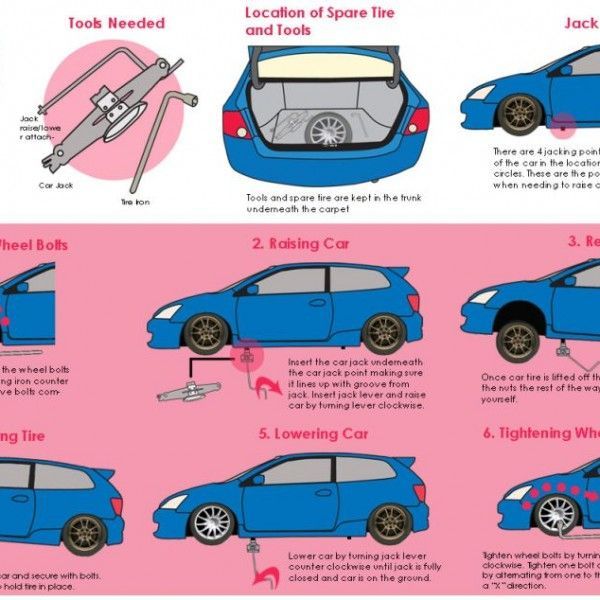 You have to lean the wheel against the hub and rotate it so that the hole on the rim aligns with the hole on the hub.
You have to lean the wheel against the hub and rotate it so that the hole on the rim aligns with the hole on the hub.
Aligning the holes on the rim, insert the wheel bolts and tighten them by hand . Do not use a wheel wrench.
Remember to tighten the wheel bolts only after the machine is on all four wheels on the ground or pavement.
After lowering the machine from the jack, proceed to tighten the wheel nuts/bolts . Manually first, as much as possible. Further with the help of a balloon key. For optimum bolt tightening, with the wheel wrench on the wheel bolt, use your foot and your body weight to spin the wheel as securely as possible. As a rule, this step of tightening the bolts must be done several times.
Put the damaged wheel back in the car, also removing the jack and wheelbrace in place . Be sure to remove any bricks or rocks from under the wheels you have placed to prevent the wheels from spinning while the car is on the jack. Your vehicle is now ready to continue on your way down the road.
Be sure to remove any bricks or rocks from under the wheels you have placed to prevent the wheels from spinning while the car is on the jack. Your vehicle is now ready to continue on your way down the road.
Please note that if the spare wheel is supplied from the factory, it is usually not designed for full use on the vehicle. Therefore, if you have installed a factory spare tire, do not accelerate above 60-70 km / h. In order to find out if it is possible to accelerate faster on the spare wheel, pay attention to the labels that are applied to the spare tire.
They are usually labeled by the manufacturer. If you did not find such warnings, then refer again to the manual for the car, which, for sure, has recommendations at what speed you are allowed to travel on the spare tire.
If, after changing a wheel while driving, you hear a repetitive knock, stop and use a wheelbrace to make sure the nuts or bolts on the wheel you have installed are tight enough (as far as possible).